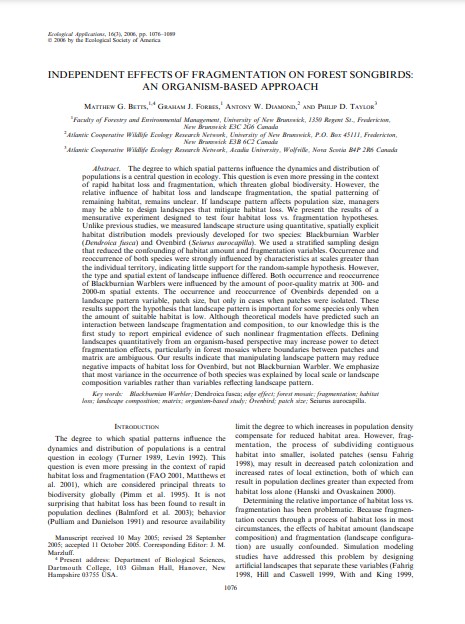Independent Effects of Fragmentation on Forest Songbirds: An Organism-based Approach
Bosque Modelo:
Fundy
Temática:
Gestión forestal
Tipo de documento:
Artículo científico
Resumen
The degree to which spatial patterns influence the dynamics and distribution of populations is a central question in ecology. This question is even more pressing in the context of rapid habitat loss and fragmentation, which threaten global biodiversity. However, the relative influence of habitat loss and landscape fragmentation, the spatial patterning of remaining habitat, remains unclear. If landscape pattern affects population size, managers may be able to design landscapes that mitigate habitat loss. We present the results of a mensurative experiment designed to test four habitat loss vs. fragmentation hypotheses. Unlike previous studies, we measured landscape structure using quantitative, spatially explicit habitat distribution models previously developed for two species: Blackburnian Warbler (Dendroica fusca) and Ovenbird (Seiurus aurocapilla). We used a stratified sampling design that reduced the confounding of habitat amount and fragmentation variables. Occurrence and reoccurrence of both species were strongly influenced by characteristics at scales greater than the individual territory, indicating little support for the random-sample hypothesis. However, the type and spatial extent of landscape influence differed. Both occurrence and reoccurrence of Blackburnian Warblers were influenced by the amount of poor-quality matrix at 300- and 2000-m spatial extents. The occurrence and reoccurrence of Ovenbirds depended on a landscape pattern variable, patch size, but only in cases when patches were isolated. These results support the hypothesis that landscape pattern is important for some species only when the amount of suitable habitat is low. Although theoretical models have predicted such an interaction between landscape fragmentation and composition, to our knowledge this is the first study to report empirical evidence of such nonlinear fragmentation effects. Defining landscapes quantitatively from an organism-based perspective may increase power to detect fragmentation effects, particularly in forest mosaics where boundaries between patches and matrix are ambiguous. Our results indicate that manipulating landscape pattern may reduce negative impacts of habitat loss for Ovenbird, but not Blackburnian Warbler. We emphasize that most variance in the occurrence of both species was explained by local scale or landscape composition variables rather than variables reflecting landscape pattern.
Información Bibliográfica
Autor:
Betts, MG, GJ Forbes, AW Diamond and PD Taylor.
Revista:
Ecological Applications
Año:
2006
N°:
3
País :
Canadá
Páginas:
1076 - 1089
Volumen:
16
Idioma:
Ingles
Palabras claves
Blackburnian Warbler; Dendroica fusca; edge effect; forest mosaic; fragmentation; habitat loss; landscape composition; matrix; organism-based study; Ovenbird; patch size; Seiurus aurocapilla.





